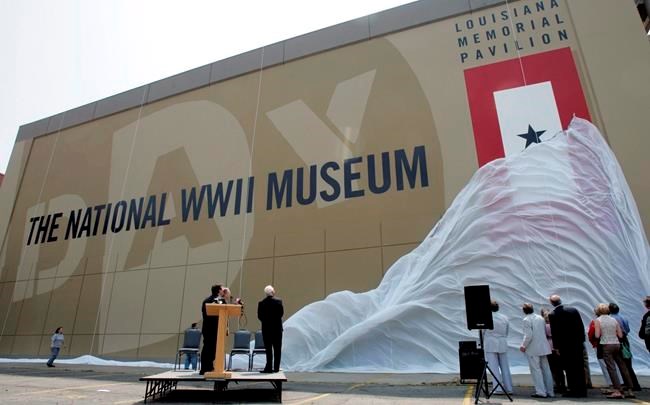NEW ORLEANS — Before the COVID-19 pandemic hit, the National WWII Museum in New Orleans was planning on a 20th anniversary crowd of thousands. Now it's working to avoid crowds by selling a limited number of scheduled tickets and holding all anniversary commemorations - including an annual D-Day morning ceremony - online.
The museum opened June 6, 2000, as the National D-Day Museum and was designated the national World War II museum a few years later. Last June 6, the landing's 75th anniversary, it logged 3,200 visitors.
With the date falling on a Saturday this year, “we could have had as many as 5,000 visitors,” president and CEO Stephen Watson said Tuesday.
The museum closed because of the pandemic on March 14 and reopened on Memorial Day to the lowest attendance since Hurricane Katrina struck in 2005, spokesman Keith Darcey said.
Daily anniversary events started Monday, with about 4,000 people logging in to watch a one-hour presentation by historian Ben Brands of the American Battle Monuments Commission. He spoke about the Normandy American Cemetery at Omaha Beach - a landing zone that accounted for nearly half of the 2,500 U.S. troops who died on D-Day.
One of Brand's stories told how a high school student’s research project helped identify a World War II radio operator whose remains were found in a salvaged Navy ship. Julius Pieper, originally buried elsewhere as unknown, was reburied at Normandy in 2018 next to his twin brother, Ludwig Pieper, Brand said.
Brands noted that the cemetery was reopening Tuesday after COVID-19 closings, though reservations are needed to visit it and indoor spaces including the visitors
In addition to the D-Day commemoration ceremony, Saturday’s events include an afternoon session about the museum’s early days and expansion into an enterprise that covers about 3
The museum has grown far beyond what fellow University of New Orleans historian Stephen Ambrose proposed over drinks as a home for the 1,000 D-Day oral histories he and his students had gathered, Mueller said Wednesday.
Ambrose thought it might cost $1 million. After all, the university owned an industrial park with a D-Day connection. The site was where Andrew Jackson Higgins built the landing craft that Dwight D. Eisenhower later said won the war.
Mueller said he answered, “Oh, Steve, you’re so naïve - it’s going to be at least $4 million.”
The site moved from the lakefront to the more touristed Warehouse District, and the original museum, now the Louisiana Pavilion, cost $20 million.
The museum survived two near-bankruptcies while it was still being planned, the recession of 2008 and - the worst hit - Hurricane Katrina, which struck in August 2005 and just after plans had been drawn up for a $300 million expansion (now $400 million).
It will survive COVID-19 losses, too, Mueller said.
The planned $60 million operating budget for the fiscal year ending June 30 will probably “end up in the low $40s,” and the next fiscal year's budget is planned at about $35 million, Darcey said in an email.
So 82 of the museum’s 300 full- and part-time employees have been laid off, though they're being paid through June 8. Forty vacancies won’t be filled, and many staffers are taking temporary pay cuts of 5% to 25%, .
The museum had fewer employees in 2005 but had to lay off about half of them, Mueller recalled. Its national board asked him back then for four or five plans ranging from
He said, “I picked one in between and told them it wasn’t as tough as Omaha Beach in 1944.”
Janet McConnaughey, The Associated Press



